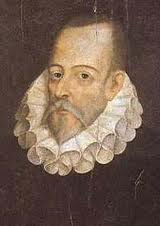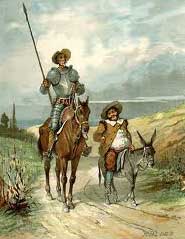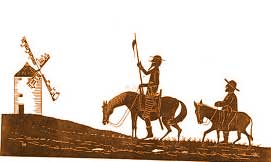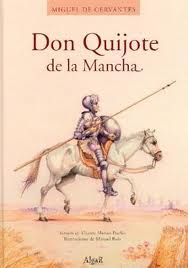Don Quixote de la Mancha

Don Quixote de la Mancha is a novel written by Miguel de Cervantes, the great Spanish writer. The first part was published under the name "El ingenioso hidalgo don Quijote de la Mancha" at the beginning of 1605, and it's considered one of the great literary works of the Spanish and universal literature, as well as one of the most translated. In 1615 the second part was published under the title "El ingenioso caballero don Quijote de la Mancha".
Don Quixote was the first antirromance novel, because it demystifies the knightly tradition. It's the first literary works that can be classified as "modern novel" and also as "polyphonic novel", and it influenced the rest of the narrative to come.
Don Quixote de la Mancha - Structure
The novel is divided into two parts: the first is called "El ingenioso hidalgo don Quijote de la Mancha" and it was published in 1605; the second part is called "El ingenioso caballero don Quijote de la Mancha" and it was published in 1615.

The first part was printed in Madrid at the end of 1604. It reached the market in January of 1605, full of typos because of the speed imposed by the publishing contract. Another edition was printed later the same year. Cervantes got the inspiration for his novel from the "Entremes de romances", which tells the story of a man who goes mad after reading a book of ballads and decides to be a knight.
This first part was published in four volumes and had a great success. It was translated into all the languages spoken in Europe, but it didn't give any economic benefits to the author because of the piracy copies: Cervantes only reserved printing privilege in Castile, and the surrounding provinces printed cheaper copies that they later sold in Castile.
Cervantes's attacks on Lope de Vega's theater (because his had been rejected from all the stages) brought on the anger of the play writer and of his friends and fans. Thus, in 1614 someone published a second part to Don Quixote, signing it with the name Alonso Fernández de Avellaneda (his real identity remains a mystery). In the prologue to this book, the writer accuses Cervantes of being jealous of Lope's success as a play writer. Although the sequel is good for an imitator, it can't really compare to Cervantes' version.
The second "real" book was published by Cervantes in 1615. In the prologue, the writer defends himself from the accusations received from the unknown Avellaneda, and laments on the difficulties of being a writer. In this novel, the writer plays with different planes of reality by including, in this second part, mentions to the first part of the novel and to the false second part, which Don Quixote and Sancho have read. They also meet several characters which have read the first part and recognize the peculiar pair, and in a lucid moment Don Quixote says that the book with his adventures will remain a classic for posterity, and a symbol of La Mancha. It turns out it was true after all!
Don Quixote de la Mancha - Topics

The thematic richness of the novel is such that it's inexhaustible; it's a spectacular recreation of the world during Cervantes's time. The main topic is the possibility of finding the ideal in the real, and it's entwined with the ethical concept of human freedom: Can we change the world or will the world change us? Is it morally acceptable, changing the world? Other themes stem from this one:
- Literary archetype: the literary critic is a constant in all of the Quixote, especially against the knight tales, the theatre of Lope de Vega and the pastoral novels.
- Love archetype: The main couple (Don Quixote and Dulcinea) aren't really together, so there are other love stories, mainly among younger people. Jealousy is also a topic, a very important one in all of Cervantes's works.
- Political archetype: An utopian archetype of politics, like when Sancho decides he wants to be Governor of an island.
Don Quixote de la Mancha - Narrative techniques

In Cervantes's time, epic could be written in prose. The narrative techniques Cervantes uses in Don Quixote are the following:
- Recapitulation or summary of the events, so the reader doesn't get lost in such a long story.
- Contrast between idealization and real life, in all levels.
- Contrast between the characters, which Cervantes likes to pair up so that one helps to construct the other through dialogue. Dialogue helps to show the different changes in temperaments and perspectives of the characters: Don Quixote becomes more like Sancho and vice versa, until the end when Don Quixote returns to sanity and Sancho looses perspective of reality, wanting to become Governor of an island. This is called perspectivism.
- Humor is a constant in the story.
- The different stories are woven together like with a loom.
- Suspense, or the creation of mysteries that help the narration along and keep the interest of the readers until their logical resolution.
- Linguistic and literary parody of different genres, languages and social roles as a formula to mixing the different points of view to offer the same blurred vision that provides the interpretation of reality.
- The orality in the language Cervantes uses, whose vivacity helps the reader feel closer to the characters, making identification easy.
- Perspectivism, which is offering a different view from each character's universe.
- Inaccuracies in the names of the characters and in details of no importance, so the readers can create their own images in some aspects of the narrative.
- Metafictional games to blur the author's figure. Cervantes includes narrative intermediaries that make the story seem more real and less literary.
Don Quixote is a must read for anyone who wants to study Spanish, since it's the best Spanish book ever written.

